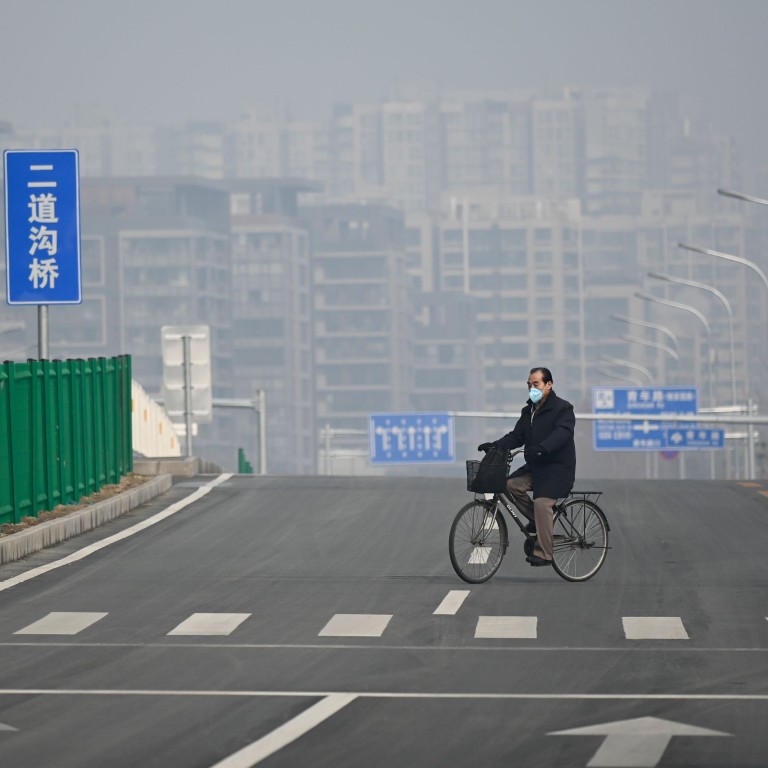
China’s capital shrouded in air pollution despite reduced emissions from coronavirus economic slowdown
- Beijing’s air quality index hit very unhealthy levels this week as local atmospheric conditions trapped pollution in the city
- Spike in poor air quality comes despite lower emissions from industry and vehicles due to the impact of the coronavirus outbreak
The poor air quality has prompted some experts to say China needs to step up its war on pollution, including strengthening regulation of coal-fired power generation.
Beijing’s air quality index (AQI) was pegged at 222 on Thursday afternoon, 22 points above the threshold for very unhealthy pollution, according to data from the Ministry of Ecology and Environment.
Readings showed that it was largely made up of harmful microscopic particulates known as PM2.5, which are most damaging to human lungs.
The United States Embassy said Beijing’s PM2.5 levels were as high as 240 micrograms per cubic metre on Thursday, more than 10 times the World Health Organisation’s recommended level of 25.
Smog blanketed skies are not uncommon in Beijing over winter, but this week’s air pollution came when emissions from industry and traffic – the two major contributors – were subdued.
Workers are only gradually returning to their jobs because of travel restrictions and new requirements that businesses provide adequate virus protection, such as masks and body temperature screenings, before restarting operations.
“Even without car emissions, these industrial and coal-fired emissions are enough to plunge Beijing into consecutive days of severe pollution amid unfavourable weather
“Even without car emissions, these industrial and coal-fired emissions are enough to plunge Beijing into consecutive days of severe pollution amid unfavourable weather,” said Ma Jun, former chief economist of China’s central bank and current director of the Institute of Public and Environmental Affairs, an NGO.
“The priority now is to continue strengthening the regulation of industry and the burning of coal.”
Car and truck traffic is still light in Beijing as many residents and tourists were staying home to avoid contracting the virus, which causes the deadly Covid-19 disease.
The volume of truck traffic dropped by 77 per cent and bus traffic by 39 per cent compared to normal levels in Beijing, neighbouring Tianjin and Hebei province surrounding the capital, according to the environment ministry.
“There are few cars on Beijing’s streets, there are shutdowns everywhere and everyone stays at home, why is there still such a severe haze for the last couple of days?” Wang Lifen, CEO of Umiwi Technology, wrote on Weibo, China’s Twitter-like social network.
“This weather really gives a feeling of The Wandering Earth ,” said a Beijing resident surnamed Zhao, referring to the Chinese sci-fi movie where the earth’s atmosphere is no longer suitable for living.
Experts have blamed the poor air quality on pollutants from industry – including steel mills and thermal power plants that continued to operate over the holiday period – and local weather.
Weak wind, high humidity and strong thermal inversion had trapped bad air in the city, even though emissions had dropped by 20 to 30 per cent compared to average, said Wang Zifa, a researcher with the Institute of Atmospheric Physics of the Chinese Academy of Sciences.
“Due to a lower level of social activities, the amount of emitted air pollutants still exceeds the environment’s capacity by more than two times, which is the main reason for the frequent smog during the recent period,” he was quoted as saying in an article published on the environmental ministry’s website.
He Kebin, dean of Tsinghua University’s School of Environment and a member of the Chinese Academy of Engineering, said unfavourable atmospheric conditions had brought pollutants from nearby regions to Beijing where they had been stuck.
The current bout of air pollution was expected to dissipate on Friday with the arrival of colder air and rain, according to Gui Hailin, chief forecaster at the National Meteorological Centre of the China Meteorological Administration.
Purchase the China AI Report 2020 brought to you by SCMP Research and enjoy a 20% discount (original price US$400). This 60-page all new intelligence report gives you first-hand insights and analysis into the latest industry developments and intelligence about China AI. Get exclusive access to our webinars for continuous learning, and interact with China AI executives in live Q&A. Offer valid until 31 March 2020.

